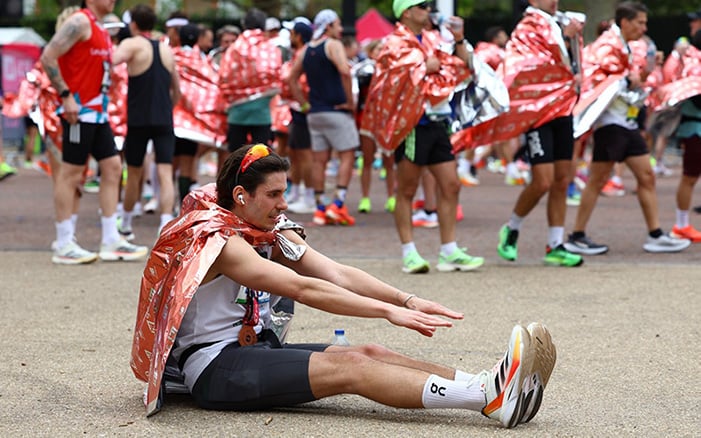Training for a marathon is tough enough—you don’t want an injury to steal the miles you’ve worked so hard for. Follow these six key rules and you’ll give yourself the best chance to stay healthy all the way to the start line.
1. Build mileage gradually
-
Build by weeks, not by days. Increase total weekly mileage by no more than 5–10%, then hold that volume for 2–3 weeks before another bump. Every 4th week, cut volume 20–30% (a step-back week).
-
Cap your long run at roughly 30% of weekly mileage in base training. If you’re running 40 miles per week, that’s about 12 miles. As mileage rises later in your cycle, long runs may reach 18–20 miles, but they should never feel like they dominate the entire week. Oversized long runs relative to weekly mileage are one of the biggest drivers of overuse injuries.
-
One needle-moving run at a time. Don’t stack a long run and a hard workout back-to-back. Separate key sessions by 48 hours with easy running or rest.
-
Keep most of your running easy. At least 80% of miles should be at conversational pace—about 1–2 min/mi slower than marathon pace (≈0:40–1:15 min/km).
-
Tame downhills. Long descents are great marathon prep but brutal on quads and tendons. Start with short, controlled descents and limit aggressive downhill segments to once per week.
2. Train strength and mobility
-
Two focused sessions per week (20–30 min). Prioritize the chain that protects knees and shins: glutes, hips, hamstrings, calves, and core.
-
Plyometric sprinkle. Add 5–10 minutes once weekly: pogo hops, line hops, short skips. This builds lower-leg stiffness that helps you tolerate marathon mileage.
-
Warm-up before every run. 30–40 yards each: high knees, butt kicks, A-skips, leg swings, ankle rolls. Then 4–6 strides at 5K effort to wake up mechanics.
-
Release what’s tight. Post-run: calves, hip flexors, glutes, hamstrings—30–45 seconds per stretch, 1–2 rounds. Foam roll tight spots for 30–60 seconds.
3. Wear the right shoes and rotate them
-
Fit first, hype second. Choose shoes that match your gait, comfort, and surface. Super shoes are great for race day, but not all bodies love them for daily miles. Get a gait analysis (ideally 3D biomechanical).
-
Rotate models. A cushioned daily trainer + a slightly firmer tempo shoe exposes tissues to different loading patterns, which can reduce repetitive stress.
-
Avoid big “drop” jumps. Shifting from a 10–12 mm drop to 0–4 mm overnight overloads calves/Achilles. Transition over 4–6 weeks.
-
Replace shoes if the midsole feels flat or your legs feel unusually beat up after routine runs.
-
Don’t change everything at once. New shoes, new insoles, new exercise, and a mileage jump in the same week is a common injury recipe.
Related: 35 Common Running Mistakes and How to Avoid Them
4. Learn to fuel and hydrate like a pro
-
Daily basics. Aim for 0.6–0.8 g of protein per lb body weight (1.4–1.8 g/kg) and carbs scaled to work: more on hard/long days, less on easy days.
-
Before long runs (2–3 hours out) eat 300–600 kcal, mostly carbs with a little protein, low fat/fiber. Top up with small sips in the final hour.
-
During runs (>90 minutes) take 30–60 g of carbs per hour (up to 90 g if trained) via gels/chews/drink mix. Practice your race fueling on long-run days.
-
Know your sweat rate. Weigh yourself before/after a long run. Each 1 lb (0.45 kg) lost ≈ 16 oz (475 ml) fluid deficit. Replace 100–150% of that over the next 2–4 hours. Sodium matters. Many marathoners do well with 300–600 mg sodium per hour in heat/humidity; heavy sweaters may need more. Personalize through practice.
-
Avoid underfueling. Persistent fatigue, disrupted sleep, repeat colds, stalled progress, or bone stress history. If these show up, increase intake and get professional guidance.
5. Respect recovery days
-
Easy means easy. Recovery runs are 20–45 minutes at a truly relaxed effort (you should be able to speak in full sentences). If you can’t, walk a minute every 10–15 minutes.
-
One full rest day weekly. No “secret cross-training.” Walk the dog, stretch, or nap. Let tissues rebuild.
-
Place your long run wisely. Sandwich it with easy or off days before and after. That placement alone lowers next-week injury risk.
-
Sleep like it’s scheduled. 7–9 hours nightly. If life is busy, protect three high-quality nights around your biggest sessions; add a 20–30 minute nap when possible.
-
Step-back weeks. Every 3–4 weeks, reduce volume 20–30% and trim intensity.
Related: The Ultimate Post-Run Recovery Guide
6. Pay attention to pain signals
Use clear thresholds so decisions aren’t emotional:
-
The “gait rule.” If pain changes your stride, stop the run. Walk home or call it a day.
-
The “two-day rule.” If a hot spot (shin, knee, Achilles, foot) hurts during a run and is still noticeable the next morning, remove intensity for 48 hours and swap one run for cycling or the elliptical.
-
The “3/10 rule.” During a run, pain above 3/10 or pain that ramps up as you continue is a stop sign.
-
The “one-week rule.” If focal pain lasts >7 days despite reduced load, get assessed by a sports-savvy clinician before resuming workouts.
Marathon training is a stress-and-adapt cycle. Keep the stress progressive and the adaptation supported: small mileage bumps, two short strength sessions, shoes that suit you, fuel that matches the work, quality recovery, and objective pain rules. Put those in place, and you can train like a marathoner and show up healthy when it counts.












